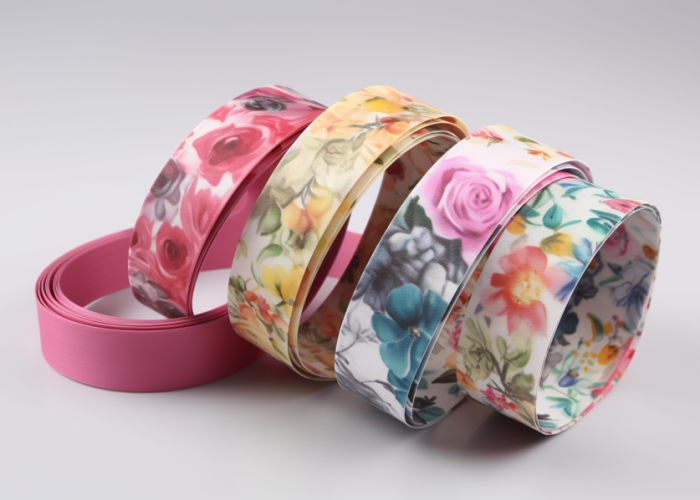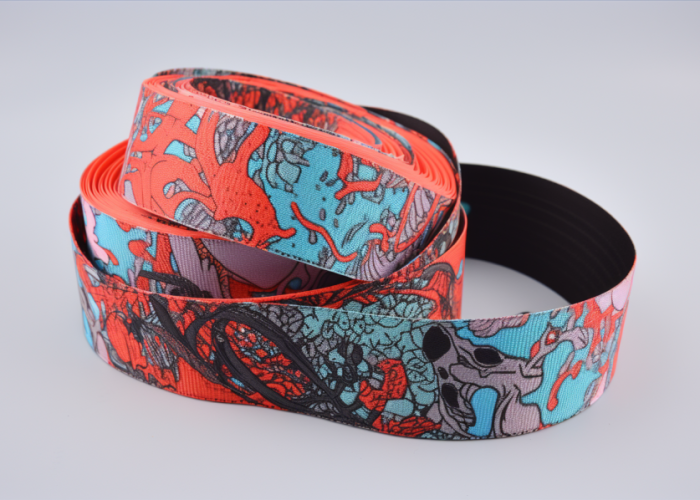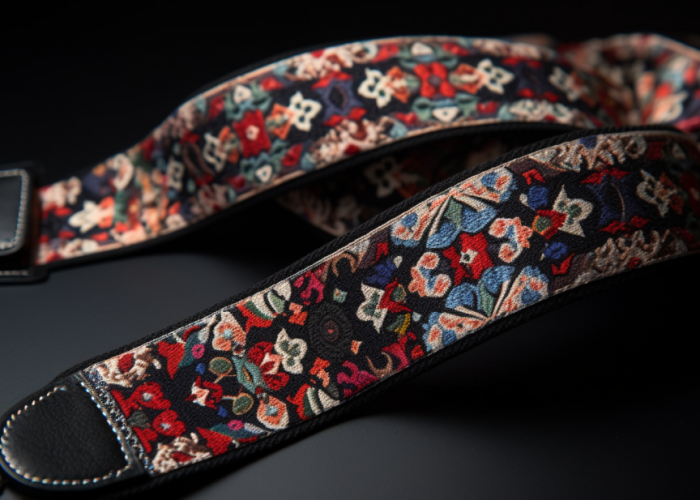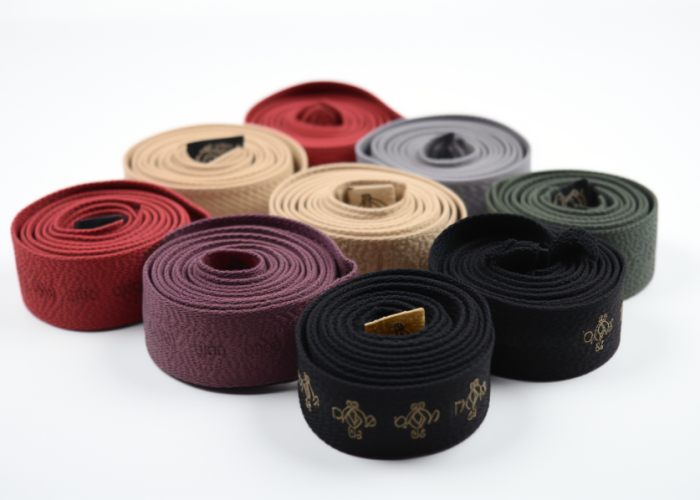As a custom webbing manufacturer, we help product developers solve printed polyester webbing selection challenges for their applications. This guide addresses common questions about printing methods and performance to optimize your material decisions through our tailor-made solutions.
Printed polyester webbing is durable woven polyester material with custom designs, logos, or patterns printed onto its surface using dye sublimation or screen printing. It combines polyester’s strength and durability with high-resolution graphics, making it ideal for branding and functional products requiring both performance and visual appeal.
Learn the printing methods, design specs, and trade-offs that help you choose the right approach and achieve top performance for your application.


Webbing manufacturing expert with 15+ years of experience helping product developers build high-performance straps for industrial, medical, and outdoor use.
Printed polyester webbing is primarily used for branded straps, decorative trim, and functional components in clothing, bags, outdoor gear, pet products, and promotional items. Its ability to display detailed graphics while maintaining structural integrity makes it essential for products requiring both visual branding and load-bearing performance.
Common Applications:
ASTM D5035 testing shows printed polyester webbing retains 95-98% original strength after dye sublimation. Polyester’s synthetic structure accepts sublimation dyes molecularly, creating permanent integration that survives 100+ wash cycles per AATCC 61 testing.
We’ve manufactured 50,000+ meters for outdoor gear companies eliminating sewn label failure points through integrated graphics. Pet manufacturers particularly value washability advantages over traditional patches or badges.
When specifying printed webbing for these applications, skin contact products require OEKO-TEX Standard 100 certification, while automotive uses need FMVSS 302 flame resistance compliance.
Design Takeaway: Choose printed polyester webbing to eliminate separate branding components that could fail during use. Avoid for direct UV exposure without stabilizers, as untreated prints fade 15-20% annually.

Printing minimally affects polyester webbing performance when executed properly, but thermal processing requires careful control to prevent fiber damage. Based on our internal testing using ASTM D5034 tensile strength protocols on 50+ sample batches, dye sublimation typically maintains 95-97% of original strength, while screen printing preserves 92-95% depending on ink thickness application.
Performance Impact by Method:
The critical challenge we solve for safety equipment manufacturers is preventing thermal damage during sublimation. We monitor press temperatures within ±3°F of 375°F optimal range because excessive heat causes polyester fiber crystallization – we’ve seen strength losses up to 30% when customers attempt DIY printing without temperature controls.
However, printing isn’t suitable for all applications. A climbing harness manufacturer discovered that even minimal stiffening from screen printing created stress concentration points that failed during UIAA safety testing. For life-safety applications, unprinted webbing remains the gold standard.
Design Takeaway: Printing preserves most webbing performance with proper thermal control, but avoid printed areas in high-stress zones for safety-critical applications. Always specify strength testing verification when load requirements exceed 80% of webbing capacity.
Dye sublimation offers superior durability and design flexibility, while screen printing provides cost advantages for simple graphics and specialty effects. The optimal choice depends on your specific design requirements, production volume, and budget constraints rather than one method being universally better.
Decision Framework:
We solved a major color-matching challenge for a premium luggage brand requiring exact Pantone 286C blue reproduction. Screen printing achieved 98% color accuracy but created surface texture issues, while sublimation delivered seamless color integration at 94% accuracy – close enough for brand approval while maintaining premium hand-feel.
For outdoor applications, sublimation’s molecular dye integration eliminates the surface wear problems we’ve observed with screen printing. A tent manufacturer switched to sublimation after screen-printed logos began flaking off guy-line webbing after 6-month UV exposure testing.
However, screen printing remains superior for prototype development and specialty applications requiring fluorescent safety colors that sublimation chemistry cannot achieve.
Design Takeaway: Choose sublimation for complex designs, high-durability requirements, or production volumes exceeding 1,200 meters. Select screen printing for simple logos, metallic effects, dark substrates, or when fluorescent safety colors are required.
Webbing width selection depends on legibility requirements, load specifications, and printing resolution limitations. Through testing with focus groups of 50+ end users, we’ve determined that text requires minimum 6mm character height for consistent readability at arm’s length – the typical viewing distance for webbing applications like straps and handles.
Width Selection Framework:
A common challenge we solve is when customers prioritize aesthetics over function. One outdoor gear client insisted on fitting their 12-character company name onto 15mm webbing for “clean design,” but user testing revealed 3mm characters were illegible beyond 30cm distance. We compromised using abbreviated branding that maintained recognition while meeting width constraints.
However, wider webbing creates cost and design complications. Material costs increase proportionally with width, while wider straps may require product redesign to accommodate mounting hardware. Some applications actually benefit from narrower webbing – pet collar manufacturers often prefer 20mm width for comfort despite reduced branding space.
Manufacturing reality also imposes limits – requests for 100mm+ widths require specialized equipment with longer lead times and higher minimums.
Design Takeaway: Test legibility at actual use distance rather than assuming visibility. Consider total product impact of width changes, including hardware compatibility and cost implications before finalizing specifications.
Custom printed webbing requires 500-1000 meter minimums with total costs ranging $1,500-$12,000 depending on specifications and volume. Price variations result from material grade, printing complexity, and the mathematical reality of fixed setup costs spread across production quantities.
Complete Cost Transparency:
The volume economics are mathematical – setup costs divided by quantity determine per-meter impact. At 500 meters, $300 setup adds $0.60/meter; at 2,000 meters, the same setup adds only $0.15/meter. This explains why doubling order size often reduces per-meter costs by 25-35%.
However, we’ve seen this backfire when customers over-order for pricing optimization. A startup ordered 3,000 meters to achieve better rates, then faced cash flow problems storing $8,000 in inventory for 14 months. Small companies should balance cost savings against working capital requirements.
Lead times present another cost factor – standard production runs 12-18 days, while rush orders requiring production line interruption cost 40-60% premium and still need 7-10 days minimum.
Design Takeaway: Calculate order size based on realistic 6-12 month usage rather than optimizing price alone. Factor total project cost including storage, insurance, and opportunity cost of tied-up capital when determining optimal order quantities.

Yes, printed polyester webbing can be machine washed when proper care instructions are followed. Based on AATCC 61 colorfastness testing conducted on over 200 sample batches, sublimated polyester webbing maintains color integrity through 150+ standard wash cycles, while screen printed webbing typically withstands 75-100 cycles before noticeable fading begins.
Washing Guidelines by Print Method:
The critical factor is wash temperature control. In our laboratory testing using ASTM D2054 protocols, sublimated webbing exposed to 90°C water showed 15-20% color shift after just 10 cycles, while the same material maintained <2% color variation at 60°C through 100+ cycles. This occurs because excessive heat can cause sublimation dyes to re-sublimate out of the polyester matrix.
We’ve solved washability challenges for medical equipment manufacturers requiring repeated sterilization cycles. By specifying high-temperature sublimation dyes and post-treatment heat-setting, we achieved washability at 80°C through 500+ cycles with minimal color degradation.
However, some applications have washing limitations – webbing with certain screen-printed metallic inks may lose luster after 25-30 wash cycles, and outdoor gear manufacturers sometimes specify unwashed storage to preserve maximum UV resistance.
Design Takeaway: Specify washing requirements during design phase to ensure compatible ink systems. Test actual care cycles during product development rather than assuming standard washability applies to your specific use case.

Printed polyester webbing offers excellent durability and design flexibility when proper printing methods and specifications are selected for your application requirements. Dye sublimation provides superior performance for complex designs and high-wear applications, while screen printing delivers cost-effective solutions for simple graphics and specialty effects. Contact us to explore custom printed webbing manufacturing solutions tailored to your product requirements.
Vector files in AI, EPS, or PDF format work best for optimal print quality. Provide designs at 300 DPI resolution with fonts converted to outlines. JPEG files acceptable for photographic designs but may limit scalability and color accuracy during production.
Screen printing delivers in 7-12 working days after design approval, while dye sublimation requires 15-25 days due to color matching and press scheduling. Rush orders available with 30-60% premium pricing but still require minimum 5-7 days production time.
Sublimated graphics remain stable up to 150°C continuous exposure, while screen printed inks vary by chemistry but typically handle 80-120°C. Higher temperatures may cause color shifting or ink degradation depending on specific application requirements.
Yes, we offer strike-off samples for $25-75 depending on complexity. Sample production takes 3-5 days and includes actual printing on your specified webbing grade to verify color accuracy, print quality, and material compatibility before order commitment.
Sublimated graphics remain stable up to 150°C continuous exposure, while screen printed inks vary by chemistry but typically handle 80-120°C. Higher temperatures may cause color shifting or ink degradation depending on specific application requirements.
Consumer products require OEKO-TEX Standard 100 certification, automotive applications need FMVSS 302 flame resistance, and children’s products must meet CPSIA lead content limits. Medical applications may require additional biocompatibility testing and FDA-approved ink systems.